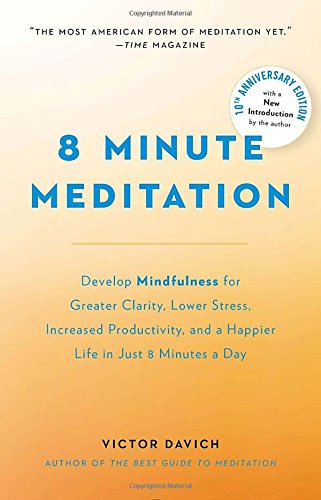Headspace For Anxiety: Life After 731 Consecutive Days Using The Headspace Meditation App
Today is my 731st of Headspace in a row.
After two years and one day of using the popular meditation app, I wanted to share my experience and advice with those considering Headspace, or meditation in general, as a way to address anxiety.
 Why meditation?
Why meditation?
8 years ago, I was diagnosed with Generalized Anxiety Disorder (GAD) with Panic Attacks.
During this time I have tried cognitive behavioral therapy (CBT), psychodynamic therapy, biofeedback therapy, around 10 different medications, and many other self-directed remedies discussed throughout this blog — all with varying degrees of success.
Despite making progress with my day-to-day anxiety and frequency of panic attacks, anxiety still lingered like a dark cloud. It was disruptive to my work and personal life. I was constantly battling negative thoughts and exhausted from the physical discomfort of anxiety. I was always on edge. I was willing to try anything.
I began meditating 4 years ago. Meditation was attractive to me as a means for anxiety relief for several reasons: you can take it with you anywhere; it’s no (or low) cost; it has a positive impact on other areas of your life like such as relationships, productivity, creativity, communication, and focus, just to name a few.
Anxiety dwells in the mind and the whole point of meditation is to control the mind. I wanted that control and I knew that I could not go wrong making a deliberate daily investment in my mental health.
What is your previous history with meditation?
I had about 2 years of sporadic meditation practice prior to Headspace.

I read 8 Minute Meditation by Victor Davich and I followed that program almost daily for 4 months. 8 Minute Meditation covers 8 different mindfulness techniques in 8 weeks. I found it a very approachable and actionable introduction to meditation. I would highly recommend it to anyone who is looking for a short read, rather than an app, to get started with meditation.
As is often the case with a healthy daily habit, I eventually fell out of practice — slowly at first, then eventually altogether. 8 Minute Meditation helped me learn effective introductory techniques but, for me personally, it was not enough to reinforce a strong daily habit at that time in my life.
Prior to Headspace, I also used the Muse Brain Sensing Headband. I bought a Muse in 2014 when the technology was very young. At the time, I was doing biofeedback therapy with a therapist. I found the electroencephalogram (EEG) sessions very helpful and the Muse Headband seemed like a great way to take those biofeedback exercises home with me.
Biofeedback (more specifically, neurofeedback, in the case of Muse) is a gradual learning process where you observe a readout of electrical brainwave activity from moment to moment. By observing the direct effect of breathing and meditative exercises, you can optimize and reinforce positive behavior.
 The Muse Headband has a substantial price point. I was skeptical that this product would work as advertised, but I was willing to take a chance because I was curious about the underlying technology. To my surprise, Muse delivered on its promise. Compared to the clunky and outdated headset the therapist was using, the Muse was a pleasure to wear and it functioned properly. The hardware was solid. If anything, the software needs a little more versatility and functionality. The Muse application is a bit one-dimensional for all the potential of the properly functioning EEG.
The Muse Headband has a substantial price point. I was skeptical that this product would work as advertised, but I was willing to take a chance because I was curious about the underlying technology. To my surprise, Muse delivered on its promise. Compared to the clunky and outdated headset the therapist was using, the Muse was a pleasure to wear and it functioned properly. The hardware was solid. If anything, the software needs a little more versatility and functionality. The Muse application is a bit one-dimensional for all the potential of the properly functioning EEG.
On the “pro” side, Muse provided structure, quantification, and tracking to daily meditation. I subscribe to the philosophy, ‘if it doesn’t get measured, it doesn’t get managed.’ You have a better chance of achieving your goals if you track your progress.
On the “con” side, ultimately, I wanted something that I could take with me anywhere. I did not like the idea of a gadget being the cornerstone of my daily meditation practice.
Though it is positioned to beginners, I believe that Muse offers the most benefit to individuals with some experience with meditation and who wish to supplement an already daily habit.
In my opinion, the Muse is a product way ahead of its time. It’s a very cool technology and I expect good things from the company in the future. I took a long break from my Muse Headband, but I recently started using it again. I am looking forward to the next generation of the product.
Technology can be an aid to meditation or a hinderance.
Meditating for the first time feels awkward, like operating a long-atrophied muscle or learning a…CLICK TO TWEET
Why Headspace?
Headspace seemed like a good balance between the technology-free and technology-heavy approaches I took to meditation in the past. Headspace lands somewhere in the middle. For better and for worse (often worse, but not always) we are tethered to our mobile devices.
 A therapist gave me a few meditation mp3s and I liked the guided format. These were one-off audio recordings and I wanted to try a series of guided sessions.
A therapist gave me a few meditation mp3s and I liked the guided format. These were one-off audio recordings and I wanted to try a series of guided sessions.
I heard good things about Headspace from a few friends and review sites. For meditation — and in other areas of life — seeking recommendations from individuals you trust can save you a lot of time sorting through choices when it is otherwise difficult to distinguish quality or find a path to get started. There are a lot of options out there for guided meditation.
I initially thought that — having a bit of a background in meditation — Headspace would be a little bit too elementary. Gladly, this turned out not to be the case. If anything, having a bit out foundational work under my belt helped me get through the all-important first 30 days of the practice. The hardest part of meditation is getting started. Meditating for the first time feels awkward, like operating a long-atrophied muscle or learning a language.
The Headspace foundation pack (30-day introductory series) and subsequent goal-focused packs are equally accessible and beneficial to a total novice as someone with a bit of experience.
How has headspace helped you? What are some tangible benefits you have experienced using Headspace for 2 years?
After 271 days of Headspace in a row, my day-to-day baseline anxiety has significantly diminished along with the frequency and intensity of panic spikes. In the past two years, I have also tackled anxiety with therapy, exercise, diet, and more, but I attribute the lion’s share of my progress to meditation. I credit my ability to stick with meditation in large part to Headspace.
Here are some specifics:
Identifying negative thought patterns as they arise
The first step to stopping negative thoughts from spiraling out of control is noticing them in the first place. The quicker you can derail a negative thought pattern, the better. The earlier, the easier.
“Noting” is a technique I learned with 8 Minute Meditation and was able to hone with Headspace. Noting allows you to simply acknowledge or recognize what is occurring in the mind without getting caught up in emotional reactions.
Noting is probably my favorite meditation technique. I am now far better at identifying thoughts that escalate and reinforce anxiety before they gain momentum.
Patience
Meditation has made me more patient with others and more patient with myself.
Having patience means being able to wait calmly in the face of frustration or adversity. No matter what the setting or circumstance, I am better equipped to handle the situation. This doesn’t mean I can handle every circumstance with ease, but without a doubt, I am more prepared for what may come.
Confidence
Headspace isn’t a single practice. Rather, it is a collection of different mindfulness techniques, each broken into 10 or 30-day packs (along with singles as well). When anxiety arises, depending on the circumstance, a different technique might be more effective than another. If my thoughts are racing, noting might be the best technique. If my heart is pounding, body scanning might be better.
Thanks to Headspace, I have more tools in my anti-anxiety toolkit and I am more confident that I can find a tool to address the problem when I need to, regardless of the situation.
I am also more confident about discussing anxiety and meditation with others. Andy Puddicombe, the co-founder and narrator of Headspace, gives good context, analogies, and direction about why you are doing certain exercises and how you should approach them. Andy’s presentation of the material makes it easy to relay to others.
I have introduced the Headspace to about two dozen people over the past two years. Probably 6 of them have built a daily meditation practice. Just 1 is a win!
Nuance and Perspective and Curiosity
Before meditation, anxiety seemed to stick to me like an amorphous blob. It was just there. It was around me. It wasn’t anywhere specific. I was like Linus from the Peanuts and his dust cloud.
In meditation, you learn to scan your body and identify areas of comfort and discomfort, then move on. You also cultivate a sense of curiosity for what’s happening within the body.
Now instead of just thinking to myself, “Go***mn, why am I a F****ng anxious?,” I can notice where anxiety is in my body. Instead, I can say, “I feel short of breath. My lower back muscles are tight. My face feels flushed. My pulse is elevated”
Breaking anxiety into pieces makes it less mysterious. It loses much of its power when you break it into pieces.
The element of curiosity also spills over into other areas of life, making you moreintunee with your surroundings. Being mindful makes the world more interesting.
Increased focus at work and managing distractions
Increased productivity has been a happy byproduct of meditation.
When distractions arise, I can identify them, and steer my attention back to the task at hand. I can also focus more intently on doing tasks well.
Appreciation
 Being more mindful lets you spend more time in the moment. This might sound obvious, but what this really means is that you spend more time appreciating what’s around you.
Being more mindful lets you spend more time in the moment. This might sound obvious, but what this really means is that you spend more time appreciating what’s around you.
Adopting an appreciative and grateful outlook increases my overall life satisfaction. It also decreases burnout and strengthens my relationships.
Headspace has an Appreciation pack that I have used more than once. When I do this pack, I combine it with a twice daily journaling exercise with the 5 Minute Journal. The 5 Minute Journal is quick and effective. I should do it every day, but I will admit that I do not. It’s a great format.
Building a daily habit and making it stick.
Initially, I just wanted to make it all the way through the 30-day foundation pack. At the time, a month in a row sounded like a pretty big win.
Once I found myself at 30 days, I thought that shooting for three consecutive months would be a good stretch goal, but I really didn’t believe I would make it there.
Instead of focusing on the far out future, I just focused on the next day. My objective was never to make it to two years of daily meditation, but I ended up there by building a habit. Getting started with meditation is the hardest part. Like any other habit, the struggle of sitting down in the morning to meditate soon softens into part of your daily routine.
At this point, it would be awkward and unfamiliar not to make time for meditation.
Being mindful makes the world more interesting.CLICK TO TWEET
Is it worth the money?
The 30-day Headspace foundation pack is free. A yearly subscription with access to the to goal focused packs is $90 a year.
I would say “yes,” it is worth the money.
Similar exercises can be found online for free and covered in less expensive books, but making an investment in Headspace is worthwhile. “Investment” is how I look at it. I believe making a nominal monetary investment in your mental health is an important symbolic gesture. I contribute time, and a few pennies every day, and I am repaid back greatly over time.
It may a bit ironic to quote Woody Allen, a famous neurotic, but he was right when he said, “Eighty percent of success is showing up.” This is certainly true with meditation.
What advice would you give to people considering Headspace or meditation in general?
It’s important to know that meditation is a challenge. You will have good sessions and bad sessions — sessions where you get 20 seconds of quiet mind and sessions where you get 2 minutes; also sessions where you get none.
Meditation is not like slipping into a warm bath of bliss. This is a common misconception. It’s hard. It takes effort and repetition. It will always be this way. In the first 12 minutes of a
In the first 12 minutes of a 15 minute meditation, your mind will be buzzing with chatter. Having the right expectations and attitude when beginning meditation will help you succeed. If you think it’s all about relaxation, you’ll quickly find that it’s not and become disillusioned and frustrated.
Also, you don’t have to go for 2 years in a row, but, consistency does make a difference. It helps to have a specific time picked out during the day. I meditate at the same time every morning, about 30 minutes after I wake up.
The final advice I would give is: start today. You have nothing to lose and lots to gain.
If you’re considering meditation I would highly recommend Headspace. Headspace may not be a fit for everyone, but I am confident it will be a fit for most people, especially for most beginners. You can download the Headspace meditation app here.




